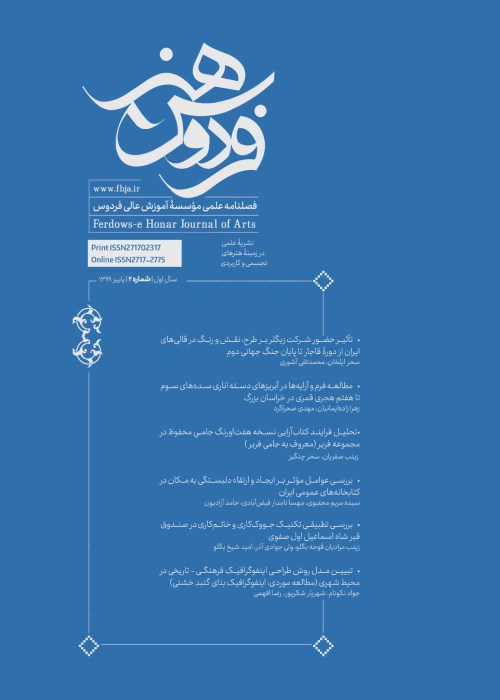A Comparative Study of the Wise Semantics of Metaphysical Beings in the Illustrated Arts of the Sassanid and Ilkhanid Periods
Since the arrival of the Aryans on the plateau of Iran and the establishment of the three tribes of Medes, Persians and Parthians in different parts of the land and also due to their ethnic and cultural spread that covers a wide area from Europe to Siberia and the Middle East and India. The maturation, formation, and expansion of beliefs, cultural traditions, and myths began increasingly in this land. These new developments, in combination with what the first inhabitants of Iran had with them, led to the formation of a set of cultural, artistic, legal, ritual and literary elements that, despite the above-mentioned developments, are a rich and strong chain. Many of the mythological and religious concepts of pre-Islamic Iran, despite the widespread invasion of Muslim Arabs, did not disappear and survived through political developments and the arrival of the new religion of Islam in Iran, with a color and smell compatible with the concepts of Islamic jurisprudence. One of the connecting perspectives of Islamic wisdom and pre-Islamic Iranian thought is Khosravani's wisdom. A way in the intellectual organization of the Iranians of the Old Testament that in the Sassanid era it took a coherent form and the fusion of myth, history and religion became a system based on monotheistic, moral principles and philosophy of life. One of the revivers of Khosravani's wisdom is Sheikh Ishraq, who laid the foundations of his wisdom of illumination based on Khosravani's wisdom and while explaining and expanding it, he dealt with the concepts of his legal structure. It is noteworthy that the legal structure resulting from this two-way relationship has led to inspiring drinking fountains for writers and illustrators, and in this way, many aesthetic phenomena related to Iranian paintings have manifested and gradually become stable traditions. They came. Fundamental issues such as imagination, the world of example, manifestation, allegory, and the like, have paved the way for the emergence of extraterrestrial forms such as angels, diffused light, demonic beings, jinns, fairies, hybrids, and other wonders. Accordingly, many images, based on their theological and theoretical foundations, find common ground with the ancient mythological forms of Iran. Created that continued to exist during the post millennia. In this way, the works created in the field of visual arts, such as volumes, stone carvings, buildings, rhytons, murals, illustrations, textiles, etc. as the crystallization and embodiment of this cultural organization, can be seen and studied. One of the prominent features of Iranian visual arts is its reliance on religious and ritual myths and principles. Therefore, the issues raised in religions and religious rites have been extensively portrayed for a higher explanation to the followers as well as the memorial aspect. Of course, the approaches of the rulers and their ruling tastes have had a great impact on the formation of artistic contexts of each period; But the spirit of works of art based on intellectual and doctrinal themes has always been current and enduring. This course has appeared in the post-Islamic period in the form of paintings in manuscripts and industrial arts. The present study, with a case study on the art of the Sassanid and Ilkhanid periods, including topics related to the iconology of the drawings in question, the hermeneutics of literary and historical texts and their translation into images, the morphology of sculptures and composite figures, text -Research of Iranian mythology in pre-Islamic and post-Islamic periods, intertextual etymology of the arrival of foreign art currents and their themes in post-Islamic Iranian art and dialectics of time based on visual style in order to achieve a synthesis between ancient Iranian art and tradition Iranian painting is Islamic. The overall purpose of this study is to achieve a specific context in imaginative and miraculous characterization in Iranian art, based on the tradition of illustrating metaphysical beings with a comparative comparison approach between pre-Islamic and post-Islamic Iranian art.What has been discussed and focused in this study includes the meanings arising from the origins of the tradition of illustrating metaphysical beings in Iran with a special and comparative approach to Sassanid art, as a representative of pre-Islamic and patriarchal Iranian art and literature, as an important part of art. And the literature of the post-Islamic era. This study aims to achieve a specific context in imaginative and miraculous characterization in Iranian art, based on the tradition of illustration of metaphysical beings with a comparative comparison approach between pre-Islamic and post-Islamic Iranian art and by selecting a selection of works of art and The fictional, theological and religious texts left over from the Sassanid and Ilkhanid periods have been based on historical studies and have explained the semantic foundations of this tradition by classifying the miraculous manifestations in the mentioned works. The present research is of a fundamental type and is carried out in a descriptive-analytical method based on a comparative and historical approach. Data were also collected based on library and electronic study. The result is that the supernatural beings depicted in the art of the mentioned periods, based on theoretical foundations, myths and rulings rooted in the intellectual and scientific traditions of ancient Iran, and in the form of artistic contexts of each period of art. Iran is manifested in a way.
Metaphysical beings , Sassanid , Ilkhanid , symbol , meaning
- حق عضویت دریافتی صرف حمایت از نشریات عضو و نگهداری، تکمیل و توسعه مگیران میشود.
- پرداخت حق اشتراک و دانلود مقالات اجازه بازنشر آن در سایر رسانههای چاپی و دیجیتال را به کاربر نمیدهد.


